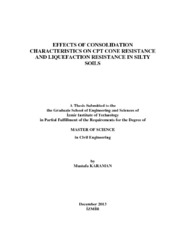Please use this identifier to cite or link to this item:
https://hdl.handle.net/11147/3659Full metadata record
| DC Field | Value | Language |
|---|---|---|
| dc.contributor.advisor | Ecemiş, Nurhan | - |
| dc.contributor.author | Karaman, Mustafa | - |
| dc.date.accessioned | 2014-07-22T13:52:03Z | - |
| dc.date.available | 2014-07-22T13:52:03Z | - |
| dc.date.issued | 2013 | - |
| dc.identifier.uri | http://hdl.handle.net/11147/3659 | - |
| dc.description | Thesis (Master)--Izmir Institute of Technology, Civil Engineering, Izmir, 2013 | en_US |
| dc.description | Includes bibliographical references (laves: 123-127) | en_US |
| dc.description | Text in English; Abstract: Turkish and English | en_US |
| dc.description | xvii, 161 leaves | en_US |
| dc.description.abstract | One of the most important reasons of the life and property losses caused by earthquakes is liquefaction during or after the earthquakes. Many researches focused on liquefaction after the earthquakes have revealed that liquefaction occurs mostly in silty soils. Empirical relationships between normalized cone penetration resistance (qc1N), cyclic resistance ratio (CRR), magnitude of earthquake (Mw), and silt content (FC), derived from field observations, are currently used for liquefaction potential assessment of loose saturated sands and silty sands. However, the effects of fine content on liquefaction resistance and penetration resistance are not defined clearly in these researches. For this reason, it is aimed to investigate the effects of fine content on consolidation characteristics and the effects of coefficient of consolidation on liquefaction resistance and cone penetration resistance. In this study, a number of field and laboratory studies were carried out to investigate the existing relationships. According to the results of experimental studies, first, the effects of the fines content on coefficient of consolidation and drainage characteristics of soils for different soil density ranges are examined and it is established that, both the fines content and the relative density effect the coefficient of consolidation of the sands and silty sands. Second, the changes in cone penetration resistance are investigated for different range of fines content and the relative density which have significant influence on coefficient of consolidation. It has been realized that the coefficient of consolidation indicates a significant influence on the measured penetration resistance during penetration of the CPT cone to the soil having different relative density, and it is figured out that for stiff-dense to medium dense soil, the decrease of normalized cone resistance is observed due to the change in drainage characteristics of fines or coefficient of consolidation. On the other hand, for loose soils only the relative density indicates a significant influence on the measured CPT penetration resistance around the probe. Finally, the contribution of the relative density on the liquefaction resistance of soils is observed at different fines content and compared with the available method in the literature. | en_US |
| dc.language.iso | en | en_US |
| dc.publisher | Izmir Institute of Technology | en_US |
| dc.rights | info:eu-repo/semantics/openAccess | en_US |
| dc.subject.lcsh | Earthquake engineering | en |
| dc.subject.lcsh | Civil engineering | en |
| dc.title | Effects of Consolidation Characteristics on Cpt Cone Resistance and Liquefaction Resistance in Silty Soils | en_US |
| dc.type | Master Thesis | en_US |
| dc.institutionauthor | Karaman, Mustafa | - |
| dc.department | Thesis (Master)--İzmir Institute of Technology, Civil Engineering | en_US |
| dc.relation.publicationcategory | Tez | en_US |
| dc.identifier.wosquality | N/A | - |
| dc.identifier.scopusquality | N/A | - |
| item.openairecristype | http://purl.org/coar/resource_type/c_18cf | - |
| item.languageiso639-1 | en | - |
| item.openairetype | Master Thesis | - |
| item.grantfulltext | open | - |
| item.fulltext | With Fulltext | - |
| item.cerifentitytype | Publications | - |
| crisitem.author.dept | 03.03. Department of Civil Engineering | - |
| Appears in Collections: | Master Degree / Yüksek Lisans Tezleri | |
Files in This Item:
| File | Description | Size | Format | |
|---|---|---|---|---|
| T001200.pdf | MasterThesis | 9.44 MB | Adobe PDF |  View/Open |
CORE Recommender
Page view(s)
288
checked on Mar 31, 2025
Download(s)
134
checked on Mar 31, 2025
Google ScholarTM
Check
Items in GCRIS Repository are protected by copyright, with all rights reserved, unless otherwise indicated.